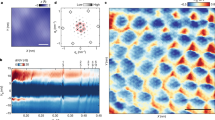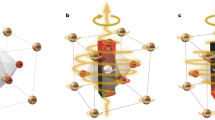Abstract
In conventional solid-state photovoltaics, electron–hole pairs are created by light absorption in a semiconductor and separated by the electric field spaning a micrometre-thick depletion region. The maximum voltage these devices can produce is equal to the semiconductor electronic bandgap. Here, we report the discovery of a fundamentally different mechanism for photovoltaic charge separation, which operates over a distance of 1–2 nm and produces voltages that are significantly higher than the bandgap. The separation happens at previously unobserved nanoscale steps of the electrostatic potential that naturally occur at ferroelectric domain walls in the complex oxide BiFeO3. Electric-field control over domain structure allows the photovoltaic effect to be reversed in polarity or turned off. This new degree of control, and the high voltages produced, may find application in optoelectronic devices.
This is a preview of subscription content, access via your institution
Access options
Subscribe to this journal
Receive 12 print issues and online access
$259.00 per year
only $21.58 per issue
Buy this article
- Purchase on Springer Link
- Instant access to full article PDF
Prices may be subject to local taxes which are calculated during checkout





Similar content being viewed by others
References
Ginley, D., Green, M. A. & Collins, R. Solar energy conversion toward 1 terawatt. Mater. Res. Soc. Bull. 33, 355–364 (2008).
Gur, I., Fromer, N. A., Geier, M. L. & Alivisatos, A. P. Air-stable all-inorganic nanocrystal solar cells processed from solution. Science 310, 462–465 (2005).
O'Regan, B. & Grätzel, M. A low-cost, high-efficiency solar cell based on dye-sensitized colloidal TiO2 films. Nature 353, 737–740 (1991).
Goldstein, B. & Pensak, L. High-voltage photovoltaic effect. J. Appl. Phys. 30, 155–161 (1959).
Brody, P. S. & Crowne, F. Mechanism for the high voltage photovoltaic effect in ceramic ferroelectrics. J. Electron. Mater. 4, 955–971 (1975).
Glass, A. M., von der Linde, D. & Negran, T. J. High-voltage bulk photovoltaic effect and the photorefractive process in LiNbO3 . Appl. Phys. Lett. 25, 233–235 (1974).
Fridkin, V. M. Bulk photovoltaic effect in noncentrosymmetric crystals. Crystallogr. Rep. 46, 654–658 (2001).
Ichiki, M., Furue, H., Kobayashi, T. & Maeda R. Photovoltaic properties of (Pb,La)(Zr,Ti)O3 films with different crystallographic orientations. Appl. Phys. Lett. 87, 222903 (2005).
Ichiki, M. et al. Photovoltaic effect of lead lanthanum zirconate titanate in a layered film structure design. Appl. Phys. Lett. 84, 395–397 (2004).
Shockley, W. & Queisser, H. J. Detailed balance limit of efficiency of p–n junction solar cells. J. Appl. Phys. 32, 510–519 (1975).
Streiffer, S. K. et al. Domain patterns in epitaxial rhombohedral ferroelectric films. I. Geometry and experiments. J. Appl. Phys. 83, 2742–2753 (1998).
Iwata, M. et al. Domain wall structure in Pb(Zn1/2Nb2/3)O3-PbTiO3-mixed crystals by atomic force microscopy. Jpn J. Appl. Phys. 43, 6812–6815 (2004).
Chu, Y.-H. et al. Domain control in multiferroic BiFeO3 through substrate vicinality. Adv. Mater. 19, 2662–2666 (2007).
Meyer, B. & Vanderbilt, D. Ab initio study of ferroelectric domain walls in PbTiO3 . Phys. Rev. B 65, 104111 (2002)
Basu, S. R. et al. Photoconductivity in BiFeO3 thin films. Appl. Phys. Lett. 92, 091905 (2008).
Choi, T., Lee, S., Choi, Y. J., Kiryukhin, V. & Cheong, S.-W. Switchable ferroelectric diode and photovoltaic effect in BiFeO3 . Science 324, 63–66 (2009).
Chu, Y.-H. et al. Nanoscale control of domain architectures in BiFeO3 thin films. Nano Lett. 9, 1726–1730 (2009).
Lubk, A., Gemming, S. & Spaldin, N. A. First-principles study of ferroelectric domain walls in multiferroic bismuth ferrite. Phys. Rev. B 80, 104110 (2009).
Romanov, A. E., Lefevre, M. J., Speck, J. S., Pompe, W. & Streiffer, S. K. Domain pattern formation in epitaxial rhombohedral ferroelectric films. II. Interfacial defects and energetic. J. Appl. Phys. 83, 2754–2765 (1998).
Chen, Y. B. et al. Ferroelectric domain structures of epitaxial (001) BiFeO3 thin films. Appl. Phys. Lett. 90, 072907 (2007).
Seidel, J. et al. Conduction at domain walls in oxide multiferroics. Nature Mater. 8, 229–234 (2009).
Lines, M. E. & Glass, A. M. Principles and Applications of Ferroelectrics and Related Materials (Clarendon Press, 1977).
Toledano, J.-C. Ferro-elasticity. Ann. Telecommun. 29, 249–270 (1974).
Chen, F. S., LaMacchia, J. T. & Fraser, D. B. Holographic storage in lithium niobate. Appl. Phys. Lett. 13, 223–225 (1968).
Odulov, S. G. Spatially oscillating photovoltaic current in iron-doped lithium niobate crystals. JETP Lett. 35, 10–12 (1982).
Anikiev, A. A., Reznik, L. G., Umarov, B. S. & Scott, J. F. Perturbed polariton spectra in optically damaged LiNbO3 . Ferroelec. Lett. 3, 89–96 (1985).
Chaib, H., Otto, T. & Eng, L. M. Electrical and optical properties of LiNbO3 single crystals at room temperature. Phys. Rev. B 67, 174109 (2003).
Scott, J. F. Interpretation of photovoltaic pulses in normal YBa2Cu3O7 . Appl. Phys. Lett. 56, 1914–1915 (1990).
Reznik, L. G., Anikiev, A. A., Umarov, B. S. & Scott, J. F. Studies of optical damage in lithium niobate in the presence of thermal gradients. Ferroelectrics 64, 215–219 (1985).
Kostritskii, S. M., Sevostyanov, O. G., Aillerie, M. & Bourson, P. Suppression of photorefractive damage with aid of steady-state temperature gradient in nominally pure LiNbO3 crystals. J. Appl. Phys. 104, 114104 (2008).
Kostritskii, S. M., Bourson, P., Mouras, R. & Fontana, M. D. Optical fatigue of undoped lithium niobate crystals caused by irreversible photorefractive damage at high-intensity illumination. Opt. Mater. 29, 732–737 (2007).
Yang, S. Y. et al. Metalorganic chemical vapor deposition of lead-free ferroelectric BiFeO3 films for memory applications. Appl. Phys. Lett. 87, 102903 (2005).
Acknowledgements
The work at Berkeley was performed within the Helios Solar Energy Research Center, which is supported by the Director, Office of Science, Office of Basic Energy Sciences, Materials Sciences and Engineering Division, of the US Department of Energy under contract no. DE-AC02-05CH11231. J.S. acknowledges support from the Alexander von Humboldt Foundation. Y.H.C. would like to acknowledge the support of the National Science Council, R.O.C., under contract no. NSC 98-2119-M-009-016.
Author information
Authors and Affiliations
Contributions
S.Y.Y. and J.S. conceived and designed the experiments. S.Y.Y., J.S. and S.J.B. performed the experiments. P.S., C.H.Y., M.D.R., P.Y., Y.-H.C. and J.W.A. contributed material and analysis. S.Y.Y., J.S., S.J.B., J.F.S., L.W.M. and R.R. co-wrote the paper.
Corresponding author
Ethics declarations
Competing interests
The authors declare no competing financial interests.
Supplementary information
Supplementary information
Supplementary information (PDF 6884 kb)
Rights and permissions
About this article
Cite this article
Yang, S., Seidel, J., Byrnes, S. et al. Above-bandgap voltages from ferroelectric photovoltaic devices. Nature Nanotech 5, 143–147 (2010). https://doi.org/10.1038/nnano.2009.451
Received:
Accepted:
Published:
Issue Date:
DOI: https://doi.org/10.1038/nnano.2009.451
This article is cited by
-
Quantifying the photocurrent fluctuation in quantum materials by shot noise
Nature Communications (2024)
-
Giant intrinsic photovoltaic effect in one-dimensional van der Waals grain boundaries
Nature Communications (2024)
-
Peculiar band geometry induced giant shift current in ferroelectric SnTe monolayer
npj Computational Materials (2024)
-
Designing Pr-based advanced photoluminescent materials using machine learning and density functional theory
Journal of Materials Science (2024)
-
Solution epitaxy of polarization-gradient ferroelectric oxide films with colossal photovoltaic current
Nature Communications (2023)



